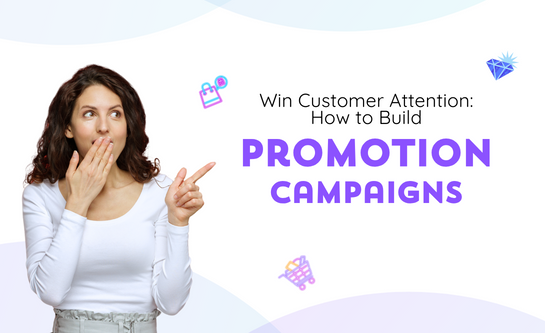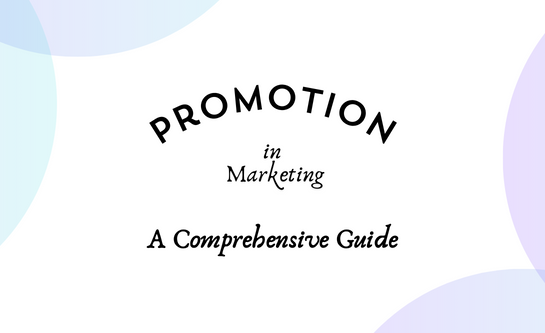Retailers Handbook: Crafting Tailored Promotion Campaigns
 May 06th, 2024
May 06th, 2024
 508 views
6 MINS READ
508 views
6 MINS READ
Retail businesses in this competitive world must utilize promotion campaigns to attract and retain customers. However, the traditional mass marketing approach is no longer sufficient, businesses need to adopt new personalized approaches to align with consumer behaviors. Hence, we will give a comprehensive guide on how to craft personalized promotion campaigns to help businesses acquire and retain more customers.
1. Stand out with audience Insights

Retail is a wide market filled with different and distinct customer preferences and shopping behaviors. Therefore, retail businesses must conduct sophisticated market research to gain valuable insights into their target audience. These insights commonly are shopping habits, preferred product categories, brand affinities, and factors influencing consumer purchasing decisions. Utilizing a combination of quantitative and qualitative methods such as surveys, focus groups, social media listening, and customer feedback, retail businesses can identify niche segments within their market and tailor promotion campaigns to resonate with their unique needs and preferences effectively.
2. Segmenting and Targeting
As consumers in the retail market have diverse preferences and purchasing behaviors, it is essential to categorize or segment them. To segment these audiences, retailers should categorize based on their age, gender, income level, lifestyle, geographic location, shopping frequency, and product preferences. For instance, a fashion retailer may segment their audience into categories such as trend-conscious millennials, budget-conscious families, and luxury shoppers. Targeting specific segments with personalized promotion campaigns allows retailers to maximize engagement rates and drive higher conversion and satisfaction.
3. Setting Objectives and KPIs
Similar to other industries, promotion campaigns in the retail field have various objectives from driving sales and building brand awareness to fostering customer loyalty. Depending on the specific goals of the business, retail marketers must establish clear and measurable objectives for their promotion campaigns. Therefore, setting SMART goals (Specific, Measurable, Achievable, Relevant, Time-bound) provides a roadmap for your campaign strategy and evaluation process. With SMART goals, businesses in the retail market can ensure the promotion campaigns align with the plan by tracking the progress of selected metrics effectively.
Besides, setting Key Performance Indicators (KPIs) is crucial in designing measurable promotion campaigns. These may include metrics like sales uplift, customer acquisition cost, conversion rate, or return on investment (ROI). Setting KPIs helps retailers measure the success of the campaign quantitatively.
4. Choosing the Right Promotion Mix
With a thorough understanding of the target audience and clear objectives in place, retailers can begin to craft their promotion mix. Promotion mix refers to the mixture of the most appropriate promotional tactics. Plus, it typically includes diverse channels such as advertising, sales promotions, public relations, direct marketing, and personal selling. However, the key is to customize the mix according to the preferences and behaviors of the target audience. For instance, younger demographics may respond better to social media promotions, while older consumers may prefer traditional advertising channels.
5. Develop Compelling Offers
Retail consumers are constantly flooded with promotional messages and offers from competing brands. Hence, retail businesses must develop compelling offers that capture the attention and interest of their target audience to stand out in a crowded marketplace. Essentially, retail businesses should consider the unique needs and pain points of each customer segment identified during the segmentation process, and tailor the offers accordingly. Whether it’s discounts, BOGO (Buy One Get One) deals, loyalty rewards, limited-time offers, exclusive access, or bundled packages, the goal is to provide value that incentivizes action. As a result, retail businesses can drive traffic to their stores, increase basket size, and stimulate repeat purchases.
6. Select the Right Channels
The retail industry involves manifold touchpoints and channels where consumers interact with brands. Retail businesses must carefully choose the channels that best reach and engage their target audience. In detail, businesses can combine digital channels such as social media, search engine advertising, and mobile apps with traditional channels like print media, outdoor advertising, and in-store signage. With the utilization of omnichannel, retail businesses can provide seamless customer experiences across touchpoints while driving brand awareness and customer loyalty.
7. Adopting personalization

As consumers seek tailored experiences, personalization is becoming a key driver in the retail industry. That is why retail businesses should utilize customer data to develop personalized promotion campaigns that offer relevant deals and experiences. The process of applying personalization comprises segmenting target audiences and delivering targeted offers and content accordingly. For instance, businesses can base on browsing behavior, demographic information, or geographic location to categorize consumer types and craft customized offers. Resultedly, developing tailored customer journeys enables retail businesses to reinforce customer relationships, and drive higher customer lifetime value.
8. Create Tempting Content
Compelling content is the cornerstone of any successful promotion campaign so retail businesses must create compelling content to communicate the value proposition of their promotion campaigns virtually. Practically, retailers could apply visual-appealing images, convincing product descriptions, informative blogs, and user-generated content. As a result, retail businesses could build strong connections with consumers and inspire them to take action thanks to the use of tempting content that is tailored to the audience’s interests and aspirations.
9. Conduct regular testing
Implementing frequent testing and adjustment is important for improving promotion campaign performances, especially in the retail industry, where consumers change constantly. Businesses can conduct A/B tests to compare different offers, messaging, creative assets, and promotional tactics, and identify which elements resonate most with their target audience. Furthermore, to gain valuable insights from promotion strategies performance, retail marketers should monitor and examine aligned metrics such as CTR and conversion rate. Conducting regular testing sessions can facilitate businesses to make data-driven decisions and maximize campaign performance.
10. Optimize for Mobile Users
With the proliferation of smartphones and mobile devices, mobile optimization is critical for retail businesses looking to engage with consumers on the go. Retailers must ensure that their promotion campaigns are mobile-responsive and accessible across a variety of devices and screen sizes. For example, businesses can optimize the designs of website layouts, email templates, and digital ads for mobile users. Moreover, providing mobile-friendly attributes like e-wallets enables retail marketers to increase the result of promotion strategies on mobile users. With these attempts to increase mobile experience, personalized promotional strategies will be effectively and seamlessly conveyed to consumers.
11. Measuring and Tracking the result
Measuring and analyzing the results of promotion campaigns is necessary for evaluating the return on investment rate in the retail industry. Businesses can calculate KPIs such as sales revenue, website traffic, conversion rates, average order value, customer acquisition cost, and customer lifetime value (CLV) to track campaigns’ performance. By applying analytics software and techniques, retail marketers can have actionable insights of consumer preferences, campaign results, and current trends. Therefore, businesses could relocate resources more effectively.
Wrap up
Designing and implementing promotion campaigns for retail businesses requires a strategic and customer-centric approach. With these mentioned approaches, retail businesses now can design tailored promotion campaigns that are relevant to your customer preferences. Last but not least, personalization is the key to unlocking the full potential of your promotion efforts in the competitive retail landscape, allowing you to stand out and capture your target audience’s mind.
 Back to blog page
Back to blog page




















